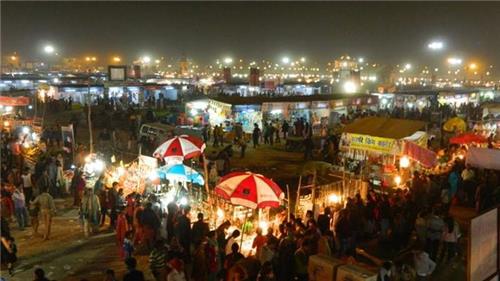
The Lucknow Mahotsav or Lucknow Festival celebrates Lucknow's living culture, which provides an insight into the old, cultured, atmosphere of the city. Colorful processions, traditional dramas, and Kathak dances in the style of the famous Lucknow Gharana, Sarangi, and Sitar recitals along with ghazals, qawwali, and thumri create a festive atmosphere.
Key Highlights
-
Cultural Performances: The festival features a wide range of cultural performances, including classical music and dance, folk dances, and modern performances by local and national artists.
-
Handicrafts and Handlooms: Artisans from across the state and country display their crafts, including chikankari (a traditional embroidery style from Lucknow), zardozi (metal embroidery), and various other handloom products.
-
Culinary Delights: Visitors can enjoy the famous Awadhi cuisine, which includes delicacies such as kebabs, biryanis, and sweets like kulfi and gulab jamun.
-
Traditional Sports: Traditional sports and games such as kite flying, cock fighting, and other indigenous games are organized during the festival.
-
Art Exhibitions: Art exhibitions displaying the works of local artists, including paintings, sculptures, and other visual arts, are a significant part of the festival.
-
Literary Events: The festival often includes literary events such as book fairs, poetry recitations, and discussions with renowned authors and poets.
-
Processions and Parades: Colorful processions and parades showcasing the cultural and historical heritage of Lucknow are a major attraction.
-
Workshops and Seminars: Various workshops and seminars on arts, crafts, and cultural traditions are organized for enthusiasts and scholars.
The celebration of the Lucknow Festival (Lucknow Mahotsav) is a vibrant and grand affair that brings together people from all walks of life to revel in the cultural richness of the city. Here's how the festival is typically celebrated:
Cultural Extravaganza
-
Music and Dance: The festival showcases a plethora of music and dance performances, ranging from classical Indian forms like Kathak and Bharatanatyam to folk dances from various regions of Uttar Pradesh. Renowned artists and local performers alike take the stage, creating a mesmerizing atmosphere.
-
Drama and Theatre: Theatrical performances, including plays and skits, often depict historical and cultural narratives related to Lucknow and its rich heritage. These performances draw large audiences and are an integral part of the festival.
Handicrafts and Art
-
Exhibitions: The festival hosts numerous stalls and exhibitions where artisans display traditional handicrafts, including the famous Lucknowi chikankari embroidery, zardozi work, and other handloom products. These stalls are a major attraction for visitors looking to purchase unique, handcrafted items.
-
Live Demonstrations: Artisans often conduct live demonstrations of their craft, allowing visitors to witness the intricate process involved in creating these traditional artworks. This interactive aspect adds to the educational value of the festival.
Culinary Delights
-
Food Stalls: The festival is a food lover’s paradise, with stalls offering a wide variety of Awadhi cuisine. From kebabs and biryanis to sweets like gulab jamun and kulfi, the culinary offerings are a significant highlight.
-
Cooking Competitions: Cooking competitions and food tasting events are organized, where local chefs and home cooks showcase their skills in preparing traditional dishes.
Traditional Sports and Games
-
Competitions: Traditional sports competitions, such as kite flying, wrestling, and cock fighting, are held, drawing enthusiastic participants and spectators. These activities reflect the cultural sports heritage of the region.
-
Interactive Games: Visitors can also participate in various traditional games and activities, adding a fun and engaging dimension to the festival.
Processions and Parades
-
Inaugural Procession: The festival often begins with a grand inaugural procession, featuring decorated floats, folk dancers, musicians, and performers. This procession traverses through the city, inviting locals and tourists to join in the celebrations.
-
Themed Parades: Themed parades highlighting different aspects of Lucknow’s history and culture are held, adding to the festive spirit and providing visual delight.
Educational and Literary Events
-
Workshops: Workshops on various arts and crafts, music, dance, and other cultural practices are conducted, offering learning opportunities for enthusiasts and students.
-
Literary Sessions: Book fairs, poetry recitations, and discussions with renowned authors and poets are a regular feature, celebrating the literary heritage of the region.
Community Engagement
-
Inclusive Celebrations: The festival promotes inclusivity by encouraging participation from diverse communities, ensuring that the celebrations reflect the cosmopolitan nature of Lucknow.
-
Social Initiatives: Various social initiatives and awareness campaigns are often integrated into the festival, addressing important social issues and promoting community welfare.
Time for the Lucknow Festival
This festival is celebrated in Lucknow, the capital city of U.P. It captures the undying elegance and splendor of the ancient city of Awadh, now known as Lucknow. The 11-day-long event captivates the everlasting grace and grandeur of the ancient city of Lucknow. This Mahotsav commemorates Lucknow’s current culture which offers perceptibility into the old and cultured atmosphere of the city. The Lucknow Festival is typically held in the winter months, usually in late November or early December, to take advantage of the pleasant weather. The primary venue for the festival is usually the sprawling grounds of the Regional Science City in Aliganj, Lucknow.
इस आर्टिकल को हिंदी में पढ़ने के लिए यहां क्लिक करें